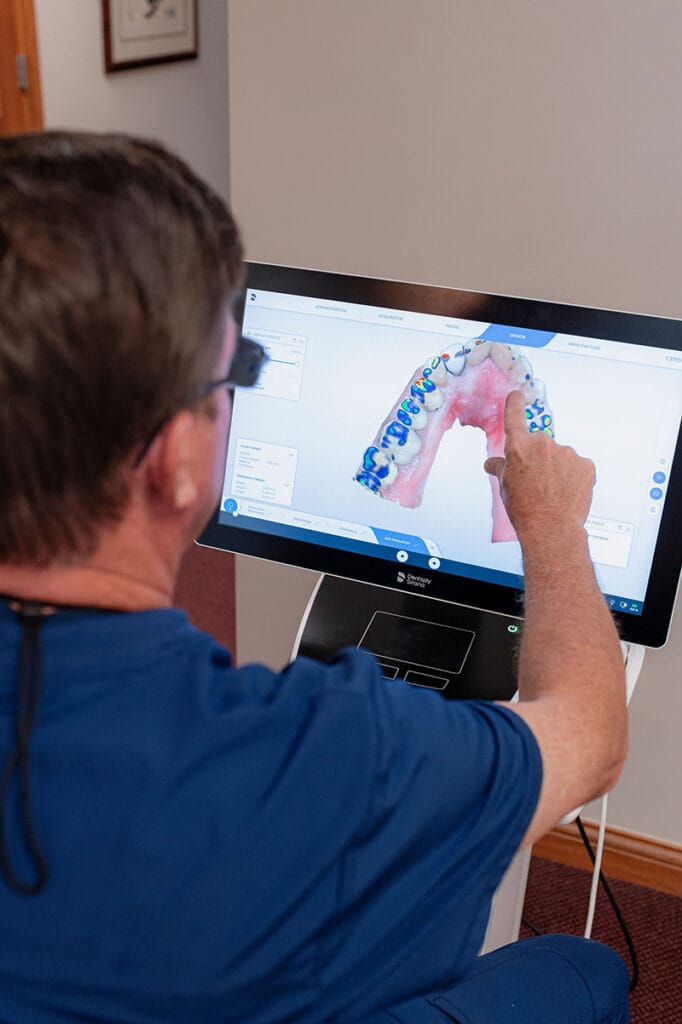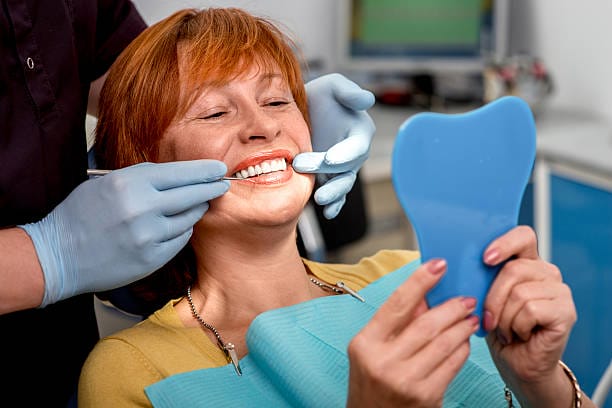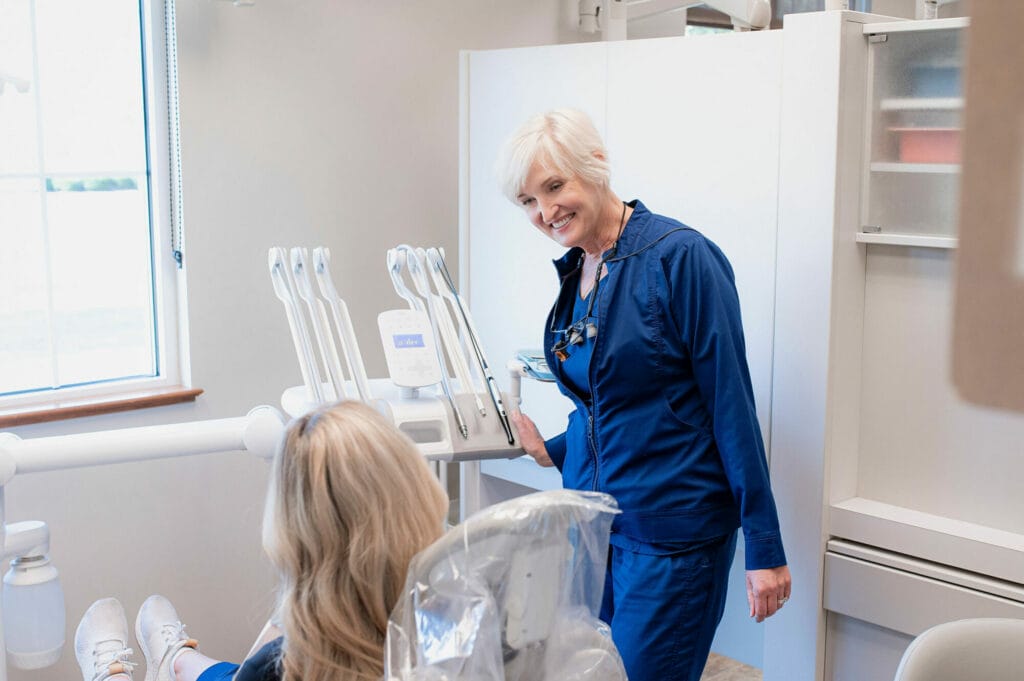Achieving a natural smile with dentures in Worthington, Ohio, is a transformative experience, and it’s one that Dr. Kevin and Dr. Connor Huelsman have been proudly facilitating for over two decades. Our dental office specializes in creating custom dentures that blend seamlessly with your natural facial features, restoring the functionality of your bite and the confidence in your smile.
Embrace the change that awaits with our dentures – call us at 614-885-8785 today!

Personalized Fitting for Dentures in Worthington, OH
Our approach to denture fitting is meticulous and patient-focused, ensuring that each set of dentures is not just a medical device but a personal enhancement to your lifestyle and well-being. Understanding that each mouth is as unique as the person it belongs to, Dr. Huelsman employs a comprehensive process to create partial and complete dentures that are comfortable, functional, and aesthetically pleasing.

Personalized Consultation and Design for Your Missing Teeth
The journey to your perfect smile begins with a personalized consultation. Dr. Huelsman takes the time to understand your specific needs, concerns, and expectations. During this initial meeting, detailed impressions and measurements of your mouth are taken, which serve as the blueprint for your custom dentures. This personalized design process ensures that your dentures align with your natural oral contours and provide the best fit when replacing missing teeth.
Precision Fit for Comfort and Function
The Huelsman commitment to precision is evident in the fit of the dentures he provides. Each denture is crafted to provide optimal comfort and function using advanced dental technology and techniques. The goal is to create dentures that allow you to speak, eat, and smile without thinking twice about them. A precise fit also means better oral health, as properly fitting dentures support the health of your gums and prevent bone loss.


Follow-Up Care and Adjustments
After your dentures have been fitted, our personalized treatment continues. Follow-up appointments are essential to the process, ensuring that your dentures continue to fit well as your mouth adjusts. Any necessary adjustments are made promptly to avoid discomfort or inconvenience.

The Technology Behind Your Dentures
Dentures are primarily made with high-quality acrylic, chosen for their durability and ability to be crafted into comfortable and aesthetically pleasing appliances. The acrylic used is designed to mimic the natural appearance of your gums, while the teeth can be made from porcelain, plastic, or a combination of both, depending on your needs and preferences. This selection of materials ensures that your dentures are solid and reliable and have a natural look that enhances your beautiful smile.
Advanced Fabrication Techniques
There are two main methods employed in the fabrication of your dentures:
- Conventional Dentures: This method involves creating dentures after all natural teeth have been removed and the gums have healed. This process ensures the fit is tailored to your mouth’s new shape, providing a comfortable and secure fit.
- Immediate Dentures: These are made in advance and can be placed in your mouth as soon as your natural teeth are extracted. The advantage is that you won’t be without teeth during the healing process, but it may require more adjustments as your gums heal and change shape.
For both types, the upper dentures include a flesh-colored acrylic base that covers the palate, while the lower dentures are designed in a horseshoe shape to accommodate the tongue.
Ensuring Longevity and Durability
To ensure that your dentures stand the test of time, they can be fabricated to fit over endodontically treated teeth or attached to dental implants. Implant-supported dentures provide a strong and secure fit, preventing the dentures from shifting in your mouth and offering confidence similar to natural teeth.
Regular dental care remains crucial even after receiving your dentures. Routine visits to Dr. Huelsman’s clinic allow for monitoring the dentures’ fit and the health of your gums, ensuring that your smile remains as vibrant and functional as the day you received your new dentures.
Schedule A Consultation Today!
Our tailored denture solutions in Worthington, Ohio, are designed to provide a comfortable, natural-looking, and functional smile that suits your lifestyle. Dr. Huelsman’s expertise in creating custom-fit, natural-looking dentures means you can enjoy life’s simple pleasures—like dining out with friends or laughing out loud at a good joke—without a second thought about your teeth.
FAQs
What Types of Dentures Are the Best, Especially for Dental Implants?
The “best” type of dentures varies depending on individual needs, preferences, and oral health conditions.
- Conventional Full Dentures are placed after the remaining teeth are removed, and the tissues have healed, which may take several months.
- Immediate Full Dentures are inserted immediately after the remaining teeth are removed.
- Partial Dentures are attached to a metal frame connected to your natural teeth and are used to fill in where permanent teeth have been removed.
Implant-supported dentures may be the best option for those looking for a more secure fit. They are anchored to dental implants surgically placed in the jawbone.
How Long Do Dentures Last?
With proper dental care, dentures can last several years. The lifespan of a denture can be anywhere from 5 to 10 years or more, but they will need to be relined, remade, or rebased over time due to normal wear.
What Type of Dentures Are Most Natural Looking?
The most natural-looking dentures are custom-fitted and made using high-quality materials that mimic natural teeth and gums’ clarity and color variations.
For example, porcelain or ceramic dentures provide the most lifelike appearance due to their glass-like sheen and ability to reflect light. However, they can be more brittle and may not be suitable for all patients.
On the other hand, acrylic resin dentures are lighter and can be adjusted more easily than porcelain. Advances in dental technology have significantly improved their appearance, making them a popular choice for a natural look.
WE LOVE OUR PATIENTS
We appreciate the opportunity to provide you with the best possible service and treat you like family and we’re proud of the reviews we receive from our patients!
CONTACT US
CONTACT US
